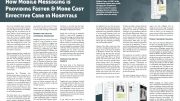The healthcare industry currently faces many challenges, from meeting ever-changing patient demands to deal with cyberattacks. The demand for efficient and secure IT solutions has never been greater. Healthcare MVPs are becoming increasingly popular as they offer a cost-effective way to bring innovative solutions to the market. However, they come with their own set of challenges to overcome.
‘Healthcare organizations need to develop products that meet the needs of their patients while providing a safe environment. We know that MVP is a great way to start because it gives you the opportunity to validate your idea fast, test the market and build and improve the concept in small milestones with fast feedback loops’ says Piotr Sobusiak, CTO and co-founder of Applover.
1. Increased risks for some groups of patients
Let’s be honest – the introduction of MVP has brought significant changes in the medical industry. However, without adequate research and validation, there is an increased risk to the health of certain groups of patients. This is especially true for patients who are more at risk, such as the elderly, pregnant women, or those with pre-existing medical conditions.
What MVP in the Health Tech industry can be implemented without much risk?
- wearable medical devices,
- apps supporting a healthy lifestyle, providing reliable content, tips, or advice,
- apps delivering clinical information or references,
- medication reminding apps,
- apps for healthy lifestyle management and health condition monitoring (e.g. heartbeat or temperature trackers wellness&fitness, diet, and rehydration control).
‘Since healthcare is about people’s lives and health, launching new digital products in this field comes with its own set of constraints. For this reason, developing such products is more complex and must follow the best practices and IT standards, thus time to market even for the MVP is usually longer to not compromise product quality. . Especially in the case of acute illnesses, complex conditions, or severe medical cases, other solutions should be considered. In cases where patients need urgent medical attention, they should use professional, well-tested software’ explains Piotr Sobusiak.
2. Changeable demands of patients
In the modern healthcare industry, patients have become more informed and empowered than ever before. They are no longer content with just being treated for their ailments, but now expect to be part of the decision-making process regarding their care. This has led to a shift in the demands of patients, from traditional treatments towards personalized and tailored care plans that meet their individual needs. As such, healthcare providers must be prepared to adapt using MVPs and respond to these changeable demands to provide quality care.
The healthcare industry is in a state of constant evolution, driven by increasing customer demands and technological advances. For healthcare providers to remain competitive, they must be prepared to adapt by utilizing Minimum Viable Products (MVPs) and be able to respond quickly to changing customer needs to provide quality care. With the right strategy, MVPs can help healthcare providers stay ahead of the curve and ensure their patients receive the best possible care.
3. Data security and compliance with regulations
A healthcare MVP should be able to meet the changing demands of patients while also protecting against cyber threats. This can be done by implementing strong security measures such as encryption, two-factor authentication, and access control systems. Additionally, healthcare organizations should invest in training their staff on best practices for data security and privacy. By doing so, they can ensure that their MVP provides a secure environment for their customers and employees alike.
‘In the age of digital technology, data security and compliance with regulations are essential for a healthcare MVP. Companies must ensure that their products are compliant with the latest data security standards and regulations to avoid any potential breaches or legal implications. Any breach of data or violation of laws can result in serious consequences, making it imperative for healthcare MVP developers to take these measures into account’ adds co-founder of Applover.
4. Prioritizing the most important features
When it comes to software and application development, prioritizing important features is critical due to limited resources and time constraints. Teams often have to make difficult decisions about which functions are most important and which can be set aside to use time and energy efficiency and focus on the most important goals. As such, addressing the challenge of properly prioritizing functions is essential for projects to meet their deadlines and achieve their goals.
The most popular of standard methods that will be perfect at the beginning of your journey when building a healthcare MVP is MoSCoW. The “Must,” “Should,” “Could,” and “Won’t” method is one of the simplest ways to prioritize tasks, making it an ideal choice for MVPs. It works particularly well when dealing with smaller products that don’t require a lot of technical barriers or dependencies.
- MUST: necessary features have to be integrated into the application, as the whole project will become a flop without them. It is imperative to have these elements if you want your project to succeed..
- SHOULD: features deemed ‘great to have’ usually don’t have a serious effect on the overall success of a project. While they’re beneficial in certain ways, you can’t rely on them as crucial components for successful outcomes.
- COULD is for minor improvements that don’t play a critical role in the project, and their absence doesn’t hinder the release.
- WON’T: represents the characteristics of the lowest importance. Due to their insignificance, they can easily be omitted or postponed to the next edition.
Another prioritization method, that’s a bit more complex than MoSCoW is the KANO model. This tool combines the product’s characteristics and the level of client satisfaction. It divides priorities into five criteria:
- Must-be: product is considered functional with these features only.
- One-dimensional: features aren’t obligatory for the product’s functioning, but they’re strongly desirable for the customers.
- Attractive: features enjoyable for the users but also unexpected, so their absence won’t disappoint them.
- Indifferent: Features don’t add any value to the product from the perspective of the customer.
- Reverse: elements that have a negative impact on the level of user satisfaction, and it’s better to give up on them.
5. The competitive market of the Healthcare industry
‘The healthcare industry is a highly competitive market where organizations are constantly looking for innovative ways to stay ahead of their competition. With the rise of technology and the increasing demand for better healthcare services, healthcare providers need to stay informed about the latest trends and advancements to remain competitive. With AI-driven solutions, healthcare providers can leverage data-driven insights to make more informed decisions and provide better care for their patients. AI technologies can also help reduce costs while improving efficiency and accuracy. In this way, AI can help organizations in the healthcare industry stay competitive in an ever-changing landscape’ concludes the CTO of Applover.
To sum up, to address these challenges, organizations must develop a comprehensive strategy that addresses all potential risks associated with their healthcare MVP. They should also ensure that their development team has the necessary expertise and resources needed to complete the project. Finally, appropriate testing and validation should be carried out throughout the development process to identify potential health risks for certain groups of patients. After all, that’s what’s most important here.





